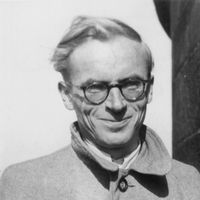Hugo Distler (24.06.1908–01.11.1942)
Hugo Distler was a German composer and Protestant church musician. For a few years he studied at the Leipzig Regional Conservatory (Leipziger Landeskonservatorium).

1. Biography
Hugo Distler was born on June 24th, 1908 in Nuremberg as the son of a dressmaker and a mechanical engineer. Even at a young age he showed his great musical talent, which was recognized and fostered by his piano teacher Carl Dupont and Erich Rhode, who taught him music theory.
He attended the Realgymnasium (secondary school with focus on languages and natural sciences) in Nuremberg before moving to Leipzig after graduation, where he lived with his aunt and cousin. In the spring of 1927 he applied to attend the Regional Conservatory (today Hochschule für Musik “Felix Mendelssohn Bartholdy” – HMT) and passed the entrance exam. Initially he started with studying conducting and piano but later on switched to composition and organ. It was his organ teacher Günther Ramin who suggested him for the position as organist at St. Jacobi Church in Lübeck in 1930. At the time Distler had not finished his studies, but after the death of his grandfather, who had paid for his schooling so far, he had to make a living on his own. On January 1st, 1931 Distler started to work as an organist. In Lübeck he wrote a large part of his sacred choral works. Because of his precarious financial situation, he had also started to direct the choir of the Handlungsgehilfenverband (clerks’ association).
In June 1933 he also accepted a position in Spandau. Those two assignments meant a large amount of work, which he soon could not handle anymore. He resigned from his position in Spandau in 1934. In October 1933 he had been appointed a lecturer at the State Conservatory in Lübeck, where he advocated establishing a separate institute for church music. His advocacy led to conflicts with the responsible minister of state Ullrich Burgstaller, who also was a pastor of the Deutsche Christen (“German Christians”, National Socialist Protestants). Eventually Distler’s proposal was approved in 1935. He never gave up on his dream to be able to live on his compositions. Despite the intensified censorship he tried again and again to find ways to be true to his art and to publicly perform his compositions. In 1936 he left Lübeck and moved to Stuttgart. Here he taught choral conducting and music theory at the conservatory and directed the conservatory’s choir as well as its church choir.
In 1940 Distler moved to Strausberg near Berlin, where he was appointed professor for choral conducting, music theory, composition and organ at the conservatory. Two years later he started to direct the Berlin state and cathedral choir (Berliner Staats- und Domchor). In Stuttgart as well as in Berlin he suffered severe personal attacks because of his commitment to church music. These attacks as well as the general political situation in National Socialist Germany led to his suicide on November 1st, 1942.
2. Private Life
Distler spend a large part of his childhood with his grandparents in Nuremberg. In 1912 his mother married the German-American Anthony Meter and moved with him to Chicago. Meter wanted to adopt the boy and take him to America, but the grandparents withheld their approval. In 1919 Distler’s mother returned to Nuremberg with her second son Anton. Her husband had died. She moved back in with her parents where her sister and niece also lived. Two weeks before his death, Distler wrote to his wife of a feeling of being “separated from all and everyone” – a feeling that he must have experienced as early as his childhood.
In 1932 Distler met his future wife Waltraut Thienhaus in Lübeck. On October 14th, 1933 they got married. The couple had three children: Barbara (1934), Andreas (1936) and Brigitte (1941). Due to the financial burden of a large family Distler always had to manage a huge workload (holding two church posts and working as lecturer and composer at the same time), which led to a nervous breakdown in 1934.
Distler was so severely unsettled by the terrible acts of war, the persecution and finally an interrogation by SS general Karl Cerff that he saw no other resort but to commit suicide by gas poisoning. Just shortly before Distler had performed the cathedral mass amongst his family. His wife and cousin finally found him dead in his company flat. “I have only one thing to ask in this world: don’t be angry with me. Who else but you knows what fear of life has been inside of me since I was born? All that I have accomplished has been under its mark.” This is what he wrote in a farewell letter to his wife, thereby showing the burden of the great sensitivity which distinguished him as an artist. Only few people from his surrounding circles knew how Distler actually felt, since he had always been dependable at work and took part in public life, in the matters of his family and in church.
3. Connection to Leipzig
After an unsuccessful application in Nuremberg, Distler started to study in Leipzig in 1927, where his aunt and cousin lived as well. Initially he wanted to start a career as music director and pianist. Encouraged by his teacher in music theory in Leipzig, Hermann Grabner, Distler decided after only a few months to relinquish this path and to become a composer instead. As Grabner’s student, whose compositions Distler valued a lot and to whom he had a father-like relationship, and under the influence of his piano teacher Carl Adolf Martienssen, Distler started to develop his own musical-compositional language, which is also clearly identifiable in his later works. But at first, he had difficulties with Grabner’s strict and very conservative compositional methods. He was inspired by modern pieces, e.g. King David by Arthur Honegger, which he saw in the Gewandhaus (concert hall). Later on, he started to take organ lessons from Günther Ramin. Teachers and fellow students noticed his great enthusiasm for his work and the seriousness with which he took up his studies.
At the recommendation of Karl Straube, two of Distler’s works that he created while he lived in Leipzig were published by Breitkopf & Härtel:
§ Concertante Sonata for two Pianos, op. 1
§ Herzlich lieb hab ich Dich, o Herr, op. 2
Distler’s as well as the works of other composers of his generation were heavily influenced by Kurt Thomas. He was the director of the church choir of the Institute for Church Music in Leipzig and additionally was one of the campaigners for the so-called “renewal” of sacred music, to which Distler contributed significantly as well.
Unfortunately, because of his financial situation, Distler’s time in Leipzig came to an early end. All the time he had to scratch a living with side jobs, which put a strain on him. In the end he found himself in such financial distress that he had to interrupt his studies and listening to the advice of his organ teacher Günther Ramin had to accept a position as organist in Lübeck, starting in January 1931. But thanks to his relatives in Leipzig he had a connection with the city throughout his life and leaving it was hard for him: “Leaving the conservatory, to which I owe so much, and taking my farewell of the city and of all she had to offer to the student, was truly hard for me. This farewell seemed to be synonymous with surrendering a career and success as an artist. I had been regarded as ambitious and aspiring and just had published my first successful compositions while I was still studying church music.”1
1 http://www.hugo-distler.de/, July 9, 2020, 10:14 a.m.
4. Reception
Hugo Distler as a person and his work have to be perceived in the context of the historical events of his time. His artistic output, for example in his motets, shows the tension between despair and crisis on the one hand and the hope of Distler as a Christian on the other hand. An area of conflict is also disclosed in his relationship to the regime of the Third Reich. It is a challenge to identify a nuanced image of his political viewpoints. Often times he is described as an opponent of National Socialism, who again and again came in conflict with organizations of the NSDAP (Nazi party), for example when the performance of his Christmas Story was forcibly prohibited by the Gestapo in 1936, or when his commitment to church music was affronted by the NS-student body in Stuttgart, or when the Hitler Youth systematically sabotaged the boy choir of Berlin cathedral. More and more often Distler attracted the SS’s attention and his attitude towards the Nazi regime grew more and more
critical. But his attempts to adapt to the regime paint another picture. As a trade-off for his permission to establish an Institute of Church Music he wrote the music for the Thingspiel cantata (Thing = old Germanic name for a meeting place, spiel = play, play on the theatrical form Singspiel) Ewiges Deutschland (Everlasting Germany) based on texts by the director of the poetry department of the Reichsschrifttumskammer (statutory corporation controlled by the Ministry of Public Enlightenment and Propaganda that regulated all written texts in Nazi Germany), Wolfram Brockmeier. In 1933 Distler joined the NSDAP, probably only following the advice of his employers, the pastor at St. Jacobi Church in Lübeck, Axel Werner Kühl and the cantor Bruno Grusnick, both of whom were members of the NSDAP.
Inwardly Hugo Distler quite certain was an opponent of the NSDAP regime. He wrote in a letter to Alfred Kreutz in 1942: “Furthermore we certainly don’t know what humankind will look like after this gruesome war – but everything will depend on it. If it continues as it is right now, back to lonesomeness […] Until then we have to endure. But they make sure that enduring is as hard as possible.”
Hugo Distler and composers of his time such as Ernst Pepping, Kurt Thomas, Johann Nepomuk David and others wrote their compositions with the aim to regenerate sacred music. Besides a return to early music and its instruments, this renewal concentrated on simple, linear and polyphonic, easy to sing structures, as could be found in Protestant chorales. Furthermore, in his paper “On the spirit of the new Protestant Church music” published in 1935 Distler writes about how music should be subordinate to the actions and rituals of church service. But he still recognizes a spiritual connection to a “truly creative individual personality”. With this open mind towards newer church music his works rank among ground-breaking compositions.
5. Works
Distler mainly became famous for his compositions of sacred and secular choir music.
Selection
- Choral Passion op. 7 for a five-part mixed choir and two precentors (1932)
- Der Jahrkreis, (1933, 52 two- and three-part choir pieces)
- Die Weihnachtsgeschichte op. 10 for mixed choir and four precentors (1933)
- Geistliche Chormusik op. 12, (1935–1941), collection of nine motets for the church year (including “Dance of Death”)
- Mörike-Chorliederbuch (1938/39), song book for choir
Furthermore, organ music such as partitas, chorale settings, and one sonata, two harpsichord concertos (1930/32 and 1935) as well as chamber music. He wrote Functional Harmony (1940).
Audio Samples
Konzert für Cembalo und Streichorchester (1935) https://www.youtube.com/watch?v=z0uU8ZXDvAo
Totentanz (1934), aus Geistliche Chormusik op. 12 https://www.youtube.com/watch?v=G8xlzT32l0s
Fürwahr, er trug unsere Krankheit, aus Geistliche Chormusik op. 12 (1935-1941) https://www.youtube.com/watch?v=QjXLWa6OSfE
6. Sources and Links
Distler-Harth, Barbara: Hugo Distler. Lebensweg eines Frühvollendeten, Schott Music 2008.
Grusnick, Bruno: Hugo Distler, Lübeck 1982.
Lüdemann, Winfried: Hugo Distler – Eine musikalische Biographie, Wissner-Verlag 2002.
Prieberg, Fred K.: Handbuch Deutsche Musiker 1933-1945, Oliver Kopf 2009.
Photo
Wikipedia, Barbara Distler-Harth, Urheber Karl Schweinsberg, 1941. Diese Datei ist unter der Creative-Commons-Lizenz „Namensnennung – Weitergabe unter gleichen Bedingungen 3.0 nicht portiert“ lizenziert




